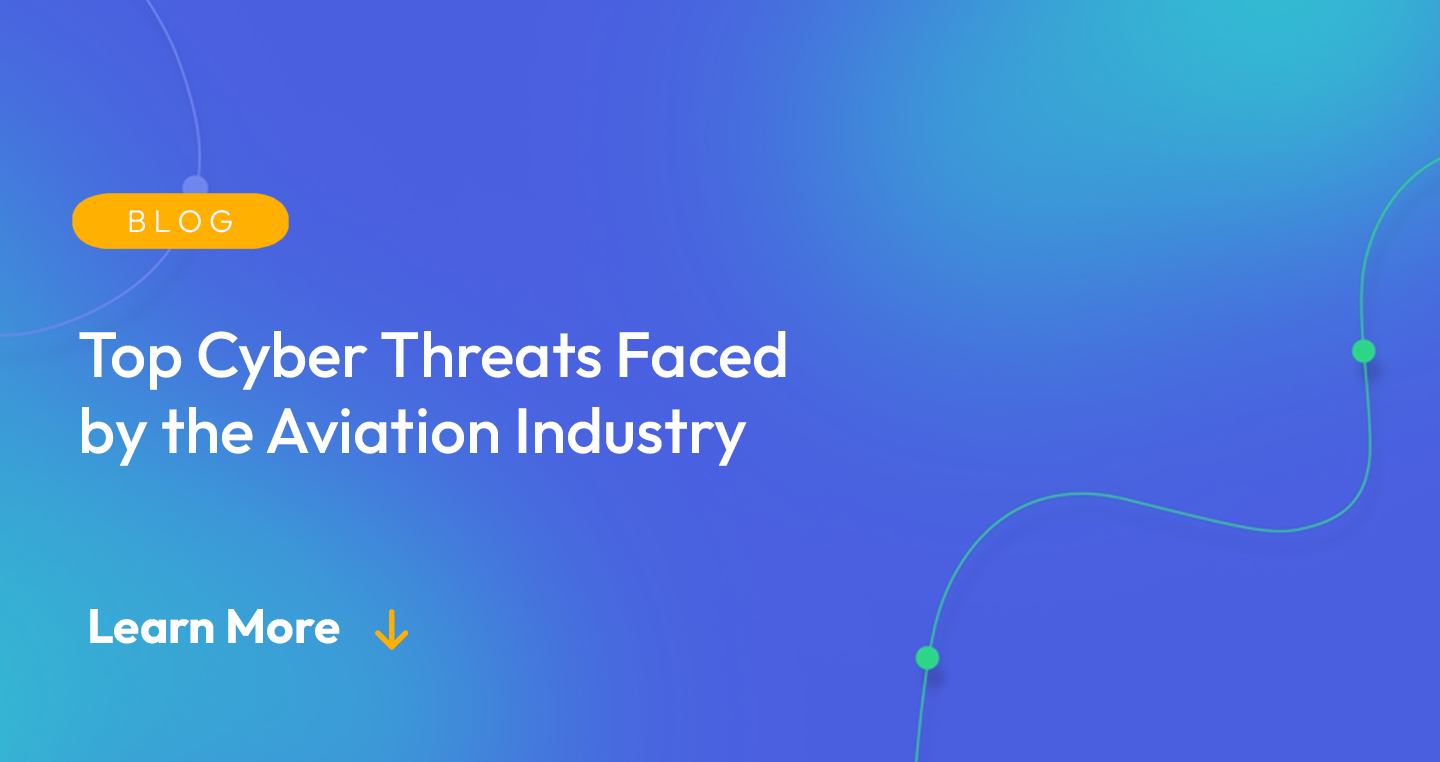
As the digital era continues to propel industries into new frontiers, the aviation industry is not left behind. However, this rapid advancement is a double-edged sword, bringing along its share of vulnerabilities.
The aviation industry, like many others, is heavily reliant on digital technology. From flight operations and air traffic control to ticketing and customer service, virtually every aspect of aviation is interwoven with complex networks and systems. This reliance is a testament to the extraordinary benefits of digitization, contributing to improved efficiency, enhanced services, and overall cost reduction. While this digital integration provides a host of advantages, it also makes the aviation industry a high-value target for cyber threats.
Understanding the Digital Landscape of the Aviation Industry
Why Threat Actors Target the Aviation Industry
To start, the aviation sector is a critical infrastructure that keeps the world connected. Disruptions in this space can have far-reaching impacts on businesses, economies, and national security. In addition, cybercriminals seek out the vast amount of sensitive data including:
- passenger information
- financial transactions
- proprietary corporate details
Aviation’s digital landscape is a complex ecosystem comprising multiple stakeholders, including airlines, airports, aircraft manufacturers, and a wide array of service providers. This ecosystem is built on a range of technologies, some old and some new, with varying degrees of cybersecurity measures. This diversity can create potential weak points or vulnerabilities that cybercriminals could exploit.
Cyber Threats in Aviation
Cyber threats in aviation can take many forms. From targeted attacks aiming to disrupt operations, to sophisticated attempts to steal data, or indirect threats such as ransomware attacks on third-party vendors.
Recognizing these complexities is the first step in understanding the cyber threat landscape of the aviation industry. It is this understanding that guides the development of effective countermeasures and security protocols.
Unveiling the Most Significant Cyber Threats in Aviation Today
As the digital landscape of the aviation industry grows more complex, so do the threats it faces. Cybercriminals are becoming more innovative and sophisticated in their attack methods, causing serious repercussions for this critical industry.
Here are some of the most pressing cyber threats affecting the aviation industry today:
Data Breaches
Data breaches are a significant concern in an industry that handles vast quantities of sensitive data, ranging from:
- passenger personal information
- credit card details
- flight data
A successful data breach can lead to financial loss, erosion of customer trust, regulatory penalties, and severe damage to the company’s reputation.
Ransomware Attacks
A ransomware attack (from groups such as Babuk or Grief) involves a cybercriminal locking an organization’s digital files and demanding a ransom to unlock them. The aviation industry, with its mission-critical systems and time-sensitive operations, is a prime target for such attacks. The fallout can be devastating, causing massive operational disruptions, financial losses, and potential safety risks.
Supply Chain Attacks
The aviation industry’s supply chain is vast and interconnected, making it an enticing target for malicious actors. These attacks can infiltrate an organization’s network through third-party vendors, causing extensive damage not just to the targeted airline but also to numerous other entities within the supply chain.
Insider Threats
While external threats often make headlines, insider threats—where an employee or trusted individual abuses their access—can be just as damaging, if not more so. Such threats can be especially challenging to detect and mitigate due to the inherent trust and access given to employees.
Spear Phishing Attacks
Phishing remains one of the most common types of cyber threats across all industries, including aviation. Phishing attacks trick employees into revealing sensitive information, such as passwords or credit card numbers, by masquerading as a trustworthy person. The potential damage can be enormous, with attackers gaining access to critical systems or sensitive data.
These threats represent just a fraction of the many cyber risks the aviation industry faces. Recognizing these threats is an essential first step in managing them.
The Impact of Cyber Threats on the Aviation Industry’s Functioning
The consequences of cyber threats in the aviation industry can ripple far beyond the immediate sphere of impact, affecting passengers, airlines, and even national security. Understanding the full scope of these impacts is crucial for comprehending the severity of the cyber threats facing the industry.
How Can Cyber Threats Disrupt the Aviation Sector?
Operational Disruptions
From flight planning and air traffic control systems to maintenance operations and boarding processes, airlines are heavily dependent on digital systems. A successful cyberattack can cause significant disruptions in these operations, leading to flight delays, cancellations, and, in severe cases, grounding of fleets. Such disruptions can incur enormous costs and tarnish an airline’s reputation.
Financial Losses
Financial impacts resulting from cyber threats can be massive and multifaceted. Direct costs include the ransoms demanded in ransomware attacks, the resources needed for incident response and system recovery, and the potential regulatory fines for data breaches. Indirect costs can encompass lost revenue due to operational disruption, reputational damage, and loss of customer trust leading to reduced sales.
Data Privacy Violations
Airlines handle sensitive personal and financial information for millions of passengers. A data breach can expose this information, violating privacy laws and regulations. This can result in regulatory fines, legal actions from affected individuals, and loss of trust among passengers and partners.
Safety Risks
While the vast majority of cyber threats aim to disrupt operations or steal data, some attacks can potentially endanger safety. For instance, if a cyberattack were to interfere with flight control systems or air traffic control, the results could be catastrophic.
National Security Implications
The aviation industry plays a crucial role in national security. A coordinated cyberattack on the aviation sector could disrupt military logistics, impede emergency response capabilities, or serve as a prelude to physical terrorist attacks.
The ramifications of cyber threats in the aviation industry are far-reaching, affecting not only the targeted organizations but also the wider ecosystem of passengers, partners, and even national security. It is these impacts that underscore the necessity for robust cybersecurity measures.
Strategies for Mitigating Cyber Threats in the Aviation Sector
In the face of evolving and escalating cyber threats, the aviation industry must prioritize a proactive and multi-layered approach to cybersecurity. Implementing robust strategies that blend people, processes, and technology can significantly reduce the industry’s vulnerability to cyberattacks.
Here are some strategies that can help mitigate cyber threats in the aviation sector:
Regular Risk Assessments
The first step in any robust cybersecurity strategy is understanding the risks. Regular risk assessments can help organizations identify their most vulnerable areas and prioritize resources effectively. Such assessments should consider both internal factors, such as employee access controls, and external factors like third-party vendors.
Employee Training and Awareness
Human error is often a contributing factor in successful cyberattacks. Regular cybersecurity training can ensure that all staff members are aware of potential threats, such as phishing emails, and understand best practices for preventing attacks.
Advanced Threat Detection and Response
Investing in advanced cybersecurity technologies can help detect and respond to threats in real-time. Tools like AI and machine learning can identify unusual activity or anomalies that could indicate a cyberattack, enabling quicker response and minimizing potential damage.
Incident Response Plan
Even with the best preventative measures, there is always a risk of a cyberattack. A well-crafted incident response plan can significantly reduce the impact of an attack. The plan should outline clear steps for identifying, isolating, and recovering from a security incident.
Collaboration and Information Sharing
The aviation industry can benefit greatly from collaboration and information sharing. By sharing threat intelligence and best practices, aviation organizations can help each other stay one step ahead of cybercriminals.
Vendor Risk Management
Given the interconnected nature of the aviation industry, it’s essential to extend cybersecurity measures to third-party vendors. Vendor risk management should include regular security audits and adherence to stringent security standards.
Regular System Updates and Patch Management
Regular system updates and patches are crucial in addressing software vulnerabilities that could be exploited by cybercriminals. An effective patch management strategy can significantly reduce the risk of a cyberattack.
By implementing these strategies, the aviation industry can strengthen its resilience against cyber threats. However, cybersecurity is not a one-time task but a continuous journey. As threats evolve, so too must the industry’s defenses. The key is remaining vigilant, adaptive, and proactive in this ever-changing digital landscape.
Monitoring Cyber Threats with Flare
The aviation industry faces cyber threats with potential impacts that are far-reaching, disrupting operations, imposing financial burdens, breaching data privacy, and potentially threatening national security. However, with a multi-layered approach to security, the aviation industry can protect itself against cyber attacks.
Flare monitors for external threats across illicit sources to prevent attacks before they happen. Book a demo to see how to monitor for any cyber threats relevant to your organization.





